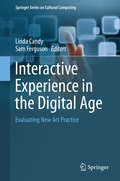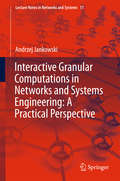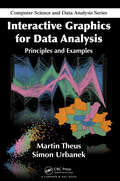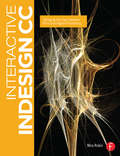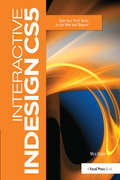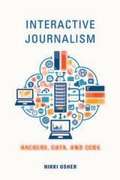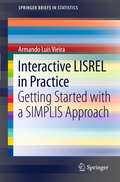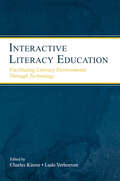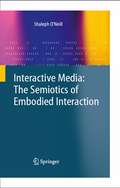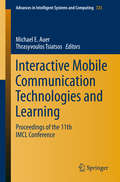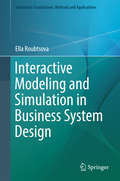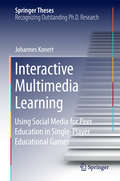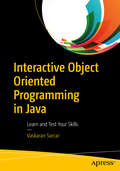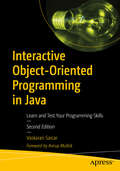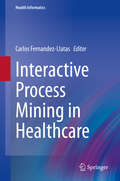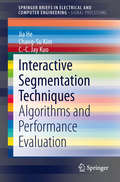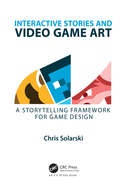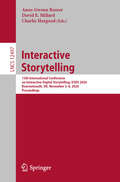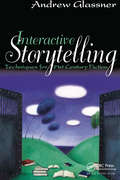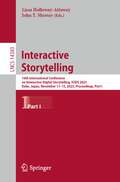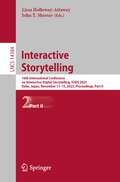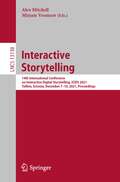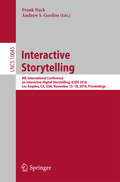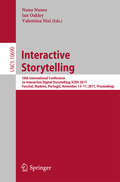- Table View
- List View
Interactive Experience in the Digital Age
by Linda Candy Sam FergusonThe use of interactive technology in the arts has changed the audience from viewer to participant and in doing so is transforming the nature of experience. From visual and sound art to performance and gaming, the boundaries of what is possible for creation, curating, production and distribution are continually extending. As a consequence, we need to reconsider the way in which these practices are evaluated. Interactive Experience in the Digital Age explores diverse ways of creating and evaluating interactive digital art through the eyes of the practitioners who are embedding evaluation in their creative process as a way of revealing and enhancing their practice. It draws on research methods from other disciplines such as interaction design, human-computer interaction and practice-based research more generally and adapts them to develop new strategies and techniques for how we reflect upon and assess value in the creation and experience of interactive art. With contributions from artists, scientists, curators, entrepreneurs and designers engaged in the creative arts, this book is an invaluable resource for both researchers and practitioners, working in this emerging field.
Interactive Granular Computations in Networks and Systems Engineering: A Practical Perspective
by Andrzej JankowskiThe book outlines selected projects conducted under the supervision of the author. Moreover, it discusses significant relations between Interactive Granular Computing (IGrC) and numerous dynamically developing scientific domains worldwide, along with features characteristic of the author's approach to IGrC. The results presented are a continuation and elaboration of various aspects of Wisdom Technology, initiated and developed in cooperation with Professor Andrzej Skowron. Based on the empirical findings from these projects, the author explores the following areas: (a) understanding the causes of the theory and practice gap problem (TPGP) in complex systems engineering (CSE); (b) generalizing computing models of complex adaptive systems (CAS) (in particular, natural computing models) by constructing an interactive granular computing (IGrC) model of networks of interrelated interacting complex granules (c-granules), belonging to a single agent and/or to a group of agents; (c) developing methodologies based on the IGrC model to minimize the negative consequences of the TPGP. The book introduces approaches to the above issues, using the proposed IGrC model. In particular, the IGrC model refers to the key mechanisms used to control the processes related to the implementation of CSE projects. One of the main aims was to develop a mechanism of IGrC control over computations that model a project's implementation processes to maximize the chances of its success, while at the same time minimizing the emerging risks. In this regard, the IGrC control is usually performed by means of properly selected and enforced (among project participants) project principles. These principles constitute examples of c-granules, expressed by complex vague concepts (represented by c-granules too). The c-granules evolve with time (in particular, the meaning of the concepts is also subject of change). This methodology is illustrated using project principles applied by the author during the implementation of the POLTAX, AlgoTradix, Merix, and Excavio projects outlined in the book.
Interactive Graphics for Data Analysis: Principles and Examples
by Martin Theus Simon UrbanekInteractive Graphics for Data Analysis: Principles and Examples discusses exploratory data analysis (EDA) and how interactive graphical methods can help gain insights as well as generate new questions and hypotheses from datasets.Fundamentals of Interactive Statistical GraphicsThe first part of the book summarizes principles and methodology, demons
Interactive InDesign CC: Bridging the Gap between Print and Digital Publishing
by Mira RubinWith a growing focus on digital destinations, the publishing landscape is evolving at a dizzying speed and InDesign CC is at the forefront of the digital frontier. Known as the premiere layout application for magazine and print collateral, InDesign is also a powerful creation tool for both static and interactive PDF, Flash SWF, EPUB, and apps that can be published for sale in various app stores. This tutorial-based guide to InDesign CC provides you with a hands-on experience of the EPUB creation process, InDesign animation, Digital Publishing Suite app creation, creation of interactive PDFs, and a host of techniques that serve equally well in both print and digital production. This extensively detailed book is filled with over 700 screenshots, explicit diagrams, and step-by-step real-world exercises to get you up and running with: *InDesign Animation *Buttons, forms, and other interactive elements *Interactive PDFs *EPUB *App building with DPS *The fundamentals of HTML, CSS, and GREP *A treasure trove of trips and techniques that will forever transform your work with InDesign.
Interactive InDesign CS5: Take your Print Skills to the Web and Beyond
by Mira RubinPrint designers make the transition to multimedia by mastering the interactive capabilities of InDesign with this tutorial-based guide to the new CS5 toolset that integrates with the Adobe Flash platform.
Interactive Journalism: Hackers, Data, and Code
by Nikki UsherInteractive journalism has transformed the newsroom. Emerging out of changes in technology, culture, and economics, this new specialty uses a visual presentation of storytelling that allows users to interact with the reporting of information. Today it stands at a nexus: part of the traditional newsroom, yet still novel enough to contribute innovative practices and thinking to the industry. Nikki Usher brings together a comprehensive portrait of nothing less than a new journalistic identity. Usher provides a comprehensive history of the impact of digital technology on reporting, photojournalism, graphics, and other disciplines that define interactive journalism. Her eyewitness study of the field's evolution and accomplishments ranges from the interactive creation of Al Jazeera English to the celebrated data desk at the Guardian to the New York Times' Pulitzer-endowed efforts in the new field. What emerges is an illuminating, richly reported portrait of the people coding a revolution that may reverse the decline and fall of traditional journalism.
Interactive LISREL in Practice: Getting Started with a SIMPLIS Approach
by Armando Luis Vieira"Getting Started with a SIMPLIS Approach" is particularly appropriate for those users who are not experts in statistics, but have a basic understanding of multivariate analysis that would allow them to use this handbook as a good first foray into LISREL. Part I introduces the topic, presents the study that serves as the background for the explanation of matters, and provides the basis for Parts II and III, which, in turn, explain the process of estimation of the measurement model and the structural model, respectively. In each section, we also suggest essential literature to support the utilization of the handbook. After having read the book, readers will have acquired a basic knowledge of structural equation modeling, namely using the LISREL program, and will be prepared to continue with the learning process.
Interactive Literacy Education: Facilitating Literacy Environments Through Technology
by Charles Kinzer Ludo VerhoevenInteractive Literacy Education combines the latest research and theory related to technology-based instructional design for children’s literacy development. It shows how technology can be used to build literacy learning environments that are compatible with students’ cognitive and social processes. Topics addressed throughout this enlightening work include:*technology environments and applications that preservice teachers can use with young children;*detailed information regarding the development and implementation of specific technological programs; and*various technologies, from interactive reading and spelling programs to speech recognition to multimedia, that teachers can use to enhance their literacy learning environments. Interactive Literacy Education is intended for graduate courses in methods of literacy instruction; educational technology; curriculum/curriculum design; general preservice education; special education; and applied psychology/cognitive studies. It is also appropriate for use as a supplement in undergraduate courses in methods of literacy instruction and educational technology.
Interactive Media: The Semiotics of Embodied Interaction
by Shaleph O'NeillThe author discusses the existing theoretical approaches of semiotically informed research in HCI, what is useful and the limitations. He proposes a radical rethink to this approach through a re-evaluation of important semiotic concepts and applied semiotic methods. Using a semiotic model of interaction he explores this concept through several studies that help to develop his argument. He concludes that this semiotics of interaction is more appropriate than other versions because it focuses on the characteristics of interactive media as they are experienced and the way in which users make sense of them rather than thinking about interface design or usability issues.
Interactive Mobile Communication Technologies and Learning
by Michael E. Auer Thrasyvoulos TsiatsosInteractive mobile technologies have now become the core of many—if not all—fields of society. Not only do the younger generation of students expect a mobile working and learning environment, but also the new ideas, technologies and solutions introduced on a nearly daily basis also boost this trend.Discussing and assessing key trends in the mobile field were the primary aims of the 11th International Conference on Interactive Mobile Communication, Technologies and Learning (IMCL2017), which was held in Thessaloniki from 30 November to 01 December 2017.Since being founded in 2006, the conference has been devoted to new approaches in interactive mobile technologies, with a focus on learning. The IMCL conferences have in the meanwhile become a central forum of the exchange of new research results and relevant trends, as well as best practices.This book contains papers in the fields of:Future Trends and Emerging Mobile TechnologiesDesign and Development of Mobile Learning Apps and ContentMobile Games—Gamification and Mobile LearningAdaptive Mobile EnvironmentsAugmented Reality and Immersive ApplicationsTangible, Embedded and Embodied InteractionInteractive Collaborative and Blended LearningDigital Technology in SportsMobile Health Care and TrainingMultimedia Learning in Music Education5G Network InfrastructureCase StudiesReal-World ExperiencesThe content will appeal to a broad readership, including policymakers, academics, educators, researchers in pedagogy and learning theory, school teachers, the learning industry, further education lecturers, etc.
Interactive Modeling and Simulation in Business System Design
by Ella RoubtsovaThis book explores the process of interactive modeling and interactive simulation. The text covers several modeling techniques that are used in the interactive cycle of modeling and simulation. There are two tendencies in modern business that increase the role of executable modeling and simulation as tools of business development and intelligence. Firstly, there are no business processes that remain unchanged for a long time. The initial requirement of simulation that the model has been developed is difficult to fulfil. In practice, the model should be often modified and extended. Secondly, modern business processes involve the human-computer communication. For those systems, the model should contain means for interaction with humans, and the modeling and simulation becomes interactive. This second tendency makes the models even more changeable as the contact of a human with models stimulates human creativity.
Interactive Multimedia Learning
by Johannes KonertThis book introduces new concepts and mechanisms regarding the usage of both social media interactions and artifacts for peer education in digital educational games. Digital games in general, and digital educational games in particular, represent an area with a high potential for interdisciplinary innovation, not only from an information technology standpoint, but also from social science, psychological and didactic perspectives. This book presents an interdisciplinary approach to educational games, which is centered on information technology and aims at: (1) improving digital management by focusing on the exchange of learning outcomes and solution assessment in a peer-to-peer network of learners; (2) achieving digital implementation by using forms of interaction to change the course of educational games; and (3) providing digital support by fostering group-formation processes in educational situations to increase both the effects of educational games and knowledge exchange at the individual level. In addition to a systematic analysis of the relationship between software architecture, educational games and social media applications, the book also presents the implemented IT systems' architectures and algorithmic solutions as well as the resulting applicable evaluation findings from the field of interactive multimedia learning.
Interactive Object Oriented Programming in Java
by Vaskaran SarcarDiscover object oriented programming with Java in this unique tutorial. This book uses Java and Eclipse to write and generate output for examples in topics such as classes, interfaces, overloading, and overriding. Interactive Object Oriented Programming in Java uniquely presents its material in a dialogue with the reader to encourage thinking and experimentation. Later chapters cover further Java programming concepts, such as abstract classes, packages, and exception handling. At each stage you'll be challenged by the author to help you absorb the information and become a proficient Java programmer. Additionally, each chapter contains simple assignments to encourage you and boost your confidence level. What You Will Learn Become proficient in object oriented programming Test your skills in the basics of Java Develop as a Java programmer Use the Eclipse IDE to write your code Who This Book Is For Software developers and software testers.
Interactive Object-Oriented Programming in Java: Learn and Test Your Programming Skills
by Vaskaran SarcarGain the fundamental concepts of object-oriented programming with examples in Java. This second edition comes with detailed coverage and enhanced discussion on fundamental topics such as inheritance, polymorphism, abstract classes, interfaces, and packages. This edition also includes discussions on multithread programming, generic programming, database programming, and exception handling mechanisms in Java. Finally, you will get a quick overview of design patterns including the full implementation of some important patterns. Interactive Object-Oriented Programming in Java begins with the fundamental concepts of object-oriented programming alongside Q&A sessions to further explore the topic. The book concludes with FAQs from all chapters. It also contains a section to test your skills in the language basics with examples to understand Java fundamentals including loops, arrays, and strings. You’ll use the Eclipse IDE to demonstrate the code examples in the book. After reading the book, you will have enhanced your skills in object-oriented programming in Java and you will be able to extend them in interesting ways.What You Will LearnDiscover object-oriented programming with Java Test your programming skills Crack Java-based interviews with confidence Use the Eclipse IDE to write code and generate outputWho This Book Is ForNovice to intermediate programmers, software developers, and software testers.
Interactive Process Mining in Healthcare (Health Informatics)
by Carlos Fernandez-LlatasThis book provides a practically applicable guide to the methodologies and technologies for the application of interactive process mining paradigm. Case studies are presented where this paradigm has been successfully applied in emergency medicine, surgery processes, human behavior modelling, strokes and outpatients’ services, enabling the reader to develop a deep understanding of how to apply process mining technologies in healthcare to support them in inferring new knowledge from past actions, and providing accurate and personalized knowledge to improve their future clinical decision-making. Interactive Process Mining in Healthcare comprehensively covers how machine learning algorithms can be utilized to create real scientific evidence to improve daily healthcare protocols, and is a valuable resource for a variety of health professionals seeking to develop new methods to improve their clinical decision-making.
Interactive Segmentation Techniques: Algorithms and Performance Evaluation
by Jia He C.-C. Jay Kuo Chang-Su KimThis book focuses on interactive segmentation techniques, which have been extensively studied in recent decades. Interactive segmentation emphasizes clear extraction of objects of interest, whose locations are roughly indicated by human interactions based on high level perception. This book will first introduce classic graph-cut segmentation algorithms and then discuss state-of-the-art techniques, including graph matching methods, region merging and label propagation, clustering methods, and segmentation methods based on edge detection. A comparative analysis of these methods will be provided with quantitative and qualitative performance evaluation, which will be illustrated using natural and synthetic images. Also, extensive statistical performance comparisons will be made. Pros and cons of these interactive segmentation methods will be pointed out, and their applications will be discussed. There have been only a few surveys on interactive segmentation techniques, and those surveys do not cover recent state-of-the art techniques. By providing comprehensive up-to-date survey on the fast developing topic and the performance evaluation, this book can help readers learn interactive segmentation techniques quickly and thoroughly.
Interactive Stories and Video Game Art: A Storytelling Framework for Game Design
by Chris SolarskiThe success of storytelling in games depends on the entire development team—game designers, artists, writers, programmers and musicians, etc.—working harmoniously together towards a singular artistic vision. Interactive Stories and Video Game Art is first to define a common design language for understanding and orchestrating interactive masterpieces using techniques inherited from the rich history of art and craftsmanship that games build upon. Case studies of hit games like The Last of Us, Journey, and Minecraft illustrate the vital components needed to create emotionally-complex stories that are mindful of gaming’s principal relationship between player actions and video game aesthetics. This book is for developers of video games and virtual reality, filmmakers, gamification and transmedia experts, and everybody else interested in experiencing resonant and meaningful interactive stories. Key Features: The first book to define a common visual and interactive language for understanding and orchestrating sophisticated stories in video games Accessible to industry professionals as well as non-developers Featured concepts apply to all media with an interactive component including: transmedia, gamification and interactive art The definitive framework for designing interactive stories
Interactive Storytelling: 13th International Conference on Interactive Digital Storytelling, ICIDS 2020, Bournemouth, UK, November 3–6, 2020, Proceedings (Lecture Notes in Computer Science #12497)
by Anne-Gwenn Bosser David E. Millard Charlie HargoodThis book constitutes the refereed proceedings of the 13th International Conference on Interactive Digital Storytelling, ICIDS 2020, held in Bournemouth, UK, in November 2020. The 15 full papers and 8 short papers presented together with 5 posters, were carefully reviewed and selected from 70 submissions. The conference offers topics in game narrative and interactive storytelling, including the theoretical, technological, and applied design practices, narrative systems, storytelling technology, and humanities-inspired theoretical inquiry, empirical research and artistic expression.
Interactive Storytelling: Techniques for 21st Century Fiction
by Andrew GlassnerWe are on the verge of creating an exciting new kind of interactive story form that will involve audiences as active participants. This book provides a solid foundation in the fundamentals of classical story structure and classical game structure and explains why it has been surprisingly difficult to bring these two activities together. With this foundation in place, the book presents several ideas for ways to move forward in this appealing quest. The author has a conversational and friendly style, making reading a pleasure.
Interactive Storytelling: 16th International Conference on Interactive Digital Storytelling, ICIDS 2023, Kobe, Japan, November 11–15, 2023, Proceedings, Part I (Lecture Notes in Computer Science #14383)
by Lissa Holloway-Attaway John T. MurrayThis two-volume set LNCS 14383 and LNCS 14384 constitutes the refereed proceedings of the 16th International Conference on Interactive Digital Storytelling, ICIDS 2023, held in Kobe, Japan, during November 11–15, 2023. The 30 full papers presented in this book together with 11 short papers were carefully reviewed and selected from 101 submissions. Additionally, the proceedings includes 22 Late Breaking Works. The papers focus on topics such as: theory, history and foundations; social and cultural contexts; tools and systems; interactive narrative design; virtual worlds, performance, games and play; applications and case studies; and late breaking works.
Interactive Storytelling: 16th International Conference on Interactive Digital Storytelling, ICIDS 2023, Kobe, Japan, November 11–15, 2023, Proceedings, Part II (Lecture Notes in Computer Science #14384)
by Lissa Holloway-Attaway John T. MurrayThis two-volume set LNCS 14383 and LNCS 14384 constitutes the refereed proceedings of the 16th International Conference on Interactive Digital Storytelling, ICIDS 2023, held in Kobe, Japan, during November 11–15, 2023.The 30 full papers presented in this book together with 11 short papers were carefully reviewed and selected from 101 submissions. Additionally, the proceedings includes 22 Late Breaking Works.The papers focus on topics such as: theory, history and foundations; social and cultural contexts; tools and systems; interactive narrative design; virtual worlds, performance, games and play; applications and case studies; and late breaking works.
Interactive Storytelling: 14th International Conference on Interactive Digital Storytelling, ICIDS 2021, Tallinn, Estonia, December 7–10, 2021, Proceedings (Lecture Notes in Computer Science #13138)
by Alex Mitchell Mirjam VosmeerThis book constitutes the refereed proceedings of the 14th International Conference on Interactive Digital Storytelling, ICIDS 2021, held in Tallinn, Estonia, in December 2021. The 18 full papers and 17 short papers, presented together with 17 posters and demos, were carefully reviewed and selected from 99 submissions. The papers are categorized into the following topical sub-headings: Narrative Systems; Interactive Narrative Theory; Interactive Narrative Impact and Application; and the Interactive Narrative Research Discipline and Contemporary Practice.
Interactive Storytelling
by Frank Nack Andrew S. GordonThis book constitutes the refereed proceedings of the 9th International Conference on Interactive Digital Storytelling, ICIDS 2016, held in Los Angeles, CA, USA, in November 2016. The 26 revised full papers and 8 short papers presented together with 9 posters, 4 workshop, and 3 demonstration papers were carefully reviewed and selected from 88 submissions. The papers are organized in topical sections on analyses and evaluation systems; brave new ideas; intelligent narrative technologies; theoretical foundations; and usage scenarios and applications.
Interactive Storytelling: 9th International Conference on Interactive Digital Storytelling, ICIDS 2016, Los Angeles, CA, USA, November 15–18, 2016, Proceedings (Lecture Notes in Computer Science #10045)
by Frank Nack Andrew S. GordonThis book constitutes the refereed proceedings of the 9th International Conference on Interactive Digital Storytelling, ICIDS 2016, held in Los Angeles, CA, USA, in November 2016. The 26 revised full papers and 8 short papers presented together with 9 posters, 4 workshop, and 3 demonstration papers were carefully reviewed and selected from 88 submissions. The papers are organized in topical sections on analyses and evaluation systems; brave new ideas; intelligent narrative technologies; theoretical foundations; and usage scenarios and applications.
Interactive Storytelling: 10th International Conference on Interactive Digital Storytelling, ICIDS 2017 Funchal, Madeira, Portugal, November 14–17, 2017, Proceedings (Lecture Notes in Computer Science #10690)
by Nuno Nunes, Ian Oakley and Valentina NisiThis book constitutes the refereed proceedings of the 10th International Conference on Interactive Digital Storytelling, ICIDS 2017, held in Funchal, Madeira, Portugal, in November 2017. The 16 revised full papers and 4 short papers presented were carefully reviewed and selected from 65 submissions. The papers are organized in topical sections on story design, location and generation, history and learning, games, emotion and personality, posters and demos.
